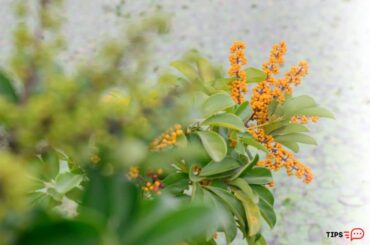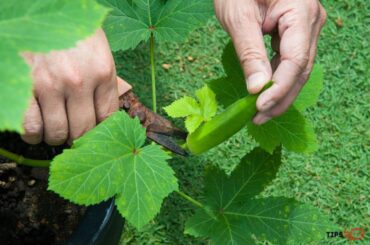Can fungicide hurt plants? They have the ability to harm the plant as well as fungus. In this article I am going to discuss potential side effects of fungicides.

Can fungicide hurt plants?
Fungicides play a vital role in the effective control of fungal diseases in plants. They kill or inhibit the growth of fungi and their spores protecting the plant from the disease. However, besides their obvious beneficial functions in plant protection, fungicides have the potential to cause some negative impacts on crop physiology.
Remember misuse, not using enough, and excessive use of the fungicides have the potential to damage your plants. You need to diagnose the disease correctly before using a fungicide. Ensure your plant needs a fungicide. If you apply a fungicide for any other disease (e.g. pest damage or bacterial infection), it can create more harm to the plant.
What are the side effects of fungicides on plants?
Researchers have discovered various mechanisms by which fungicides cause phytotoxicity. You may observe phytotoxicity symptoms like leaf spots or discoloration, necrosis, and deformation caused by the misuse of fungicides. Certain contact fungicides such as copper and sulfur and some systemic fungicides like anilides, benzimidazoles, and pyrimidine can cause phytotoxicity.
Fungicides can interfere with important metabolic pathways of the plant, especially with photosynthesis which can lead to growth retardation and reduction of crop yield. Moreover, fungicides have been reported to be toxic to certain beneficial microflora or soil microorganisms of the plants.
For instance, cyanobacteria; a group of bacteria that provides nitrogen required to plant growth, can be destroyed by fungicides. Due to that, the plant may lose some of its vital benefits. There is a risk of prolonged exposure to a chemical of a fungicide leading pathogens to develop resistance.
When they developed resistance against a particular chemical, they will be less susceptible to every fungicide belonging to that same chemical family. The severity of the effects of fungicides depends on their active form, concentration, persistence, and the development stage of the plant. Generally, plants at the younger stage and the reproduction stage are more vulnerable.
What does fungicide do to plants?
Contact fungicides (e.g. copper and sulfur) are known to be proactive fungicides as they prevent the disease before occurring by killing fungi and spores. Systemic fungicides (e.g. myclobutanil, chlorothalonil, and captan) are said to be curative fungicides as they are used when the plant is infected.
All these compounds are capable of protecting the plants from fungal diseases, problems can arise mainly due to the misapplication. If absorbed in sufficient quantities, Copper, one of the most critical elements used in contact fungicides (e.g. Bordeaux mixture) can cause serious harm to the plant by killing plant tissues.
Copper ions can enter the inner plant tissues through stomates, and hydathodes. New plant leaves are more susceptible to copper toxicity with their thin protective cuticle layer. Avoid mixing copper-based fungicides with acids as they can generate more copper ions creating more space for plant damage.
Further, you should never mix surfactants with copper fungicides as they can damage foliage. Surfactants facilitate the spreading of copper over more surface areas on the leaves. Excess copper on leaves can penetrate through the cuticle and stomates which can result in tissue damage.
Certain contact fungicides disturb photosynthesis by damaging chloroplasts. Copper disrupts the lipid chloroplast membrane and interferes with pigment accumulation and chlorophyll integration affecting the photosynthesis process.

Can fungicide burn your plants?
Phytotoxicity, in other words, plant burn by the fungicide is possible if you misuse or misapply them to the plant. When an excess of chemicals of fungicides is sprayed on plants it can penetrate the plant tissues and damage the cells. Plant burn symptoms take several days to a week to become visible. Plant burn symptoms include leaf spots or patches, leaf margin necrosis (browning or yellowing), leaf distortion (curls, cupping, or crinkles), abnormal plant growth, and stunting.
You can easily diagnose plant burns by comparing young leaves with old leaves where fungicides were sprayed. As the plant grows, newly developing leaves appear healthy whilst older ones remain damaged. Phytotoxicity may happen when you spray fungicides on stressed plants. Usually, plants get stressed under harsh conditions like disease, and hot and humid weather.
Even if you use non-toxic sprays there is a possibility of plant burns if the plant is stressed. To avoid this, you should apply fungicides during dry, calm, and cool conditions. It would be better if you can apply fungicides below 85OF. You can prevent the occurrence of phytotoxicity by strict adherence to the directions that come with the fungicide label. Never do any tasks with the product unless it is allowed by the manufacturer.
Can you put down fungicide and fertilizer at the same time?
Most of the time you can combine fungicide and fertilizer simultaneously with no serious harm to the plant as long as both of the products’ labels match. However, there are some considerations that you should never forget if you want to apply fungicide and fertilizer simultaneously. Generally, fertilizers need water to dissolve and break down to enter the soil. It means you have to water the plant after applying fertilizer.
This will cause leaching of the fungicide into the soil if the fungicide is applied along with fertilizer. Certain contact fungicides (e.g. copper, and sulfur) require to remain on the plant surface for their intended action. Watering will wash off these fungicides and hence fungicides may no longer be capable of doing their protective action.
Fosetyl-aluminum is an acidic fungicide. This will cause problems if it is mixed with metal micronutrients available in the fertilizer. Remember that under acidic conditions some of the contact fungicides like copper can lead to phytotoxicity. However, on the plus side, you can combine nutrients like urea, glucoheptonate chelates, potassium nitrate, and magnesium sulfate with a wide range of fungicides.
In this sense, first, read the labels of the products for the information to decide whether you can use the particular fungicide and the fertilizer at the same time. If you want to apply fertilizer and fungicide simultaneously, apply them to a few test plants first to ensure the combination is safe.

Can you mix fungicide in soil?
There are soil-applied fungicides that protect the plant from pathogenic fungi growing in the soil. Soil fungicides come in many forms from pH buffers to bio fungicides. Bio fungicides are the formulation of living organisms (fungi, bacteria, or actinomycetes) used to control the activity of fungi and bacteria that cause plant diseases.
These microbes form a wide range of antibiotic substances inducing localized or systemic resistance in plants. You should mix bio fungicides into the soil before planting the plant. Further, since they are living organisms, bio fungicides should be reapplied frequently to ensure the presence of enough population of them.
In contrast to bio fungicides, there are fungicides you should not mix in soil. For example, a well-known contact fungicide, copper should not be applied to the soil. They should be sprayed onto the plant.
To Wrap up
Summing up, when selecting a particular fungicide, you should consider the correct amount of use, method of application, and the time of application. Further, certain plants need certain types of fungicide. Usually, a list of effective plants is mentioned on the package of the fungicide. Even though you are using a natural fungicide, make sure to follow the directions that come with it.
References
- Budiyanto, M.A.K., 2018, July. A Typology of Fungicide Application in Malang Raya. In 2018 3rd International Conference on Education, Sports, Arts and Management Engineering (ICESAME 2018) (pp. 71-74). Atlantis Press.
- Roberts, J.W., 1946. Recent Developments in Fungicides. II Spray Materials-1936-1944. Botanical Review, 12(9), pp.538-547.
Read Next : Orchid Water Culture Mold | Are The Dangerous?




